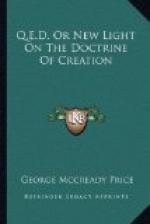In the case of a form of bacteria which reaches maturity and redivides in half an hour, the number of individual forms existing at the end of two days would need about twenty-eight figures to represent it. Doubtless these forms never multiply at this rate uninterruptedly for any great length of time, or else they would occupy the whole world to the exclusion of every other form of life. And doubtless instances arise where the period of growth to maturity and division is prolonged to several times the half-hour period mentioned above. But in any case, as we contemplate the length of time during which such well marked diseases as diphtheria, leprosy, or the plague have been known, we must acknowledge that these unicellular forms seem to breed true during a most astonishingly long period. How can we deny that this “persistence” of these unicellular forms constitutes a very strong argument in favor of the “fixity” of these forms?
III
But we must proceed to examine the behavior of the various kinds of cells of which the various multicellular organisms are composed.
Plants were known to be composed of cells, and their cells were studied and described some years before it was understood that animals also are composed of cells as units. Even then, however, the first propounders of the cell theory (Schleiden and Schwann) had no clear or accurate idea of the origin of cells, or of their essential characters and structure. As to origin, they supposed that cells arose by a sort of crystallization from a mother liquor; and as to structure, they looked upon the cell-wall as the really important part, the fluid contents being quite subordinate. Hugo von Mohl (1846) applied to the fluid contents of the cell the term “protoplasm,” and Max Schultze (1861) showed that this protoplasm is really identical in all organisms, plants and animals, also that the cell-wall is frequently absent in many animal tissues and in many unicellular forms, indicating that the protoplasm is the really important substance. By this time also it had become known that cells never arise de novo, as had been supposed by the earlier investigators, but that cells arise only by division of preexisting cells; or as Rudolf Virchow (1858) expressed it, “omnis cellula e cellul[=a].”
It was, however, many years before the details of the growth and reproduction of the cells (cell-division) became well understood. Not until the last quarter of the nineteenth century was it settled that the nucleus of the cell is also a supremely important part; but finally in 1882 Flemming was able to extend Virchow’s aphorism to the nucleus also: omnis nucleus e nucleo.




